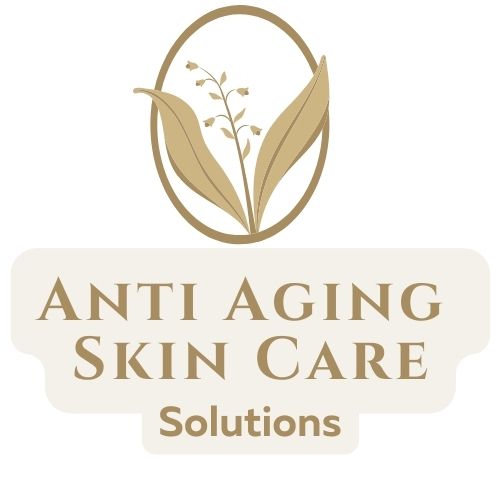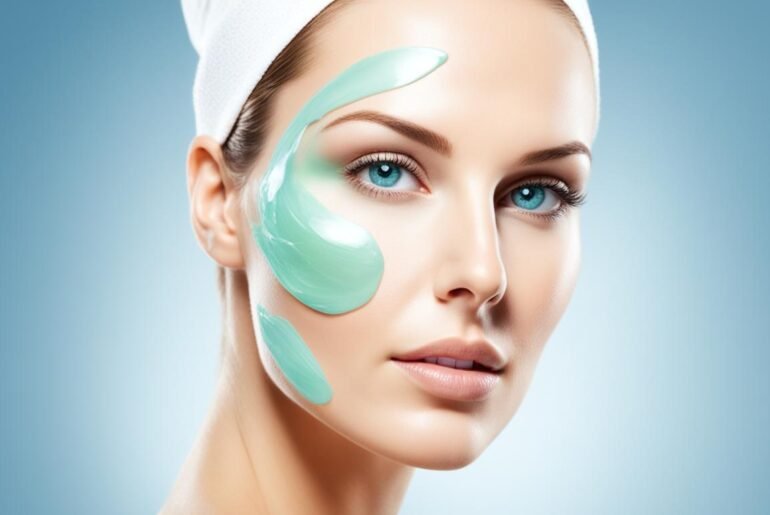
Did you know that incorporating omega-3 fatty acids into your skincare routine can have a transformative effect on your skin? These essential fatty acids, which cannot be produced by our bodies, play a vital role in maintaining a healthy complexion. From strengthening and smoothing the skin’s surface to repairing the skin barrier and reducing signs of aging, omega-3 fatty acids offer a wide range of benefits for your skin. Whether obtained through diet or skincare products, incorporating omega-3 into your routine can make a significant difference in the health and appearance of your skin.
Key Takeaways:
- Omega-3 fatty acids are essential for maintaining a healthy complexion.
- They strengthen and smooth the skin’s surface, repair the skin barrier, and reduce signs of aging.
- Omega-3 fatty acids can be obtained through diet or by using skincare products that contain them.
- Incorporating omega-3 into your skincare routine can deliver remarkable benefits for your skin.
- Consult with a healthcare professional before starting any new supplements.
What are Omega Fatty Acids?
Omega fatty acids are essential for good health and play a crucial role in maintaining the well-being of our skin. There are three types of Omega fatty acids that are particularly beneficial for our skin:
- Omega-6 (Linoleic Acid): Found in oils such as safflower, grapeseed, sunflower, soybean, and sesame oils.
- Omega-3 (Alpha-linoleic Acid): Found in fish oils, vegetable oils, walnut oil, and leafy vegetables.
- Omega-9 (Oleic Acid): Found in olive, sunflower, flaxseed oils, and macadamia nuts.
These Omega fatty acids provide various benefits for our skin, helping to nourish, protect, and improve its overall health and appearance.
To better understand the importance of Omega fatty acids, let’s take a closer look at each type:
Omega-6 (Linoleic Acid)
Omega-6 fatty acid is known for its moisturizing properties and ability to strengthen the skin’s barrier function. It helps to maintain the skin’s natural moisture balance and prevent water loss, keeping the skin hydrated and supple.
Omega-3 (Alpha-linoleic Acid)
Omega-3 fatty acid is renowned for its anti-inflammatory properties, making it effective in soothing and calming irritated and sensitive skin. It also helps to repair and strengthen the skin’s barrier, promoting a healthy complexion.
Omega-9 (Oleic Acid)
Omega-9 fatty acid is known for its nourishing and regenerating properties. It helps to improve the skin’s elasticity and repair damaged skin cells, resulting in a more youthful and radiant appearance.
By incorporating Omega fatty acids into our skincare routine, whether through topical application or dietary intake, we can harness their remarkable benefits for our skin’s health and vitality.
Benefits of Omega Fatty Acids for Skin

Omega fatty acids offer numerous skin benefits, making them a valuable addition to your skincare routine. Let’s explore the various advantages they provide:
1. Strengthen and Smooth the Skin’s Surface
Omega fatty acids help strengthen the skin’s surface, resulting in a smoother and more youthful appearance.
2. Repair the Skin Barrier
These acids play a crucial role in repairing the skin barrier, which acts as a protective shield. By enhancing the barrier function, Omega fatty acids help prevent moisture loss and maintain optimal hydration levels.
3. Soothe Irritated and Sensitive Skin
Omega fatty acids possess soothing properties that calm and alleviate irritated and sensitive skin. They can help reduce redness, inflammation, and discomfort.
4. Reduce UV-Induced Photo Damage and Signs of Aging
The antioxidant properties of Omega fatty acids help combat the damaging effects of UV radiation. They help reduce the appearance of fine lines, wrinkles, and hyperpigmentation caused by sun exposure.
5. Eliminate Dryness
Omega fatty acids deliver deep hydration to the skin, making it a beneficial ingredient for combatting dryness. They help replenish moisture and restore the skin’s natural balance.
6. Nourish and Protect Against Environmental Damage
These fatty acids provide nourishment to the skin, promoting a healthy and radiant complexion. They also protect the skin from environmental stressors, such as pollution and free radicals, that can accelerate aging.
7. Help Regulate Oil Production and Maintain Elasticity
Omega fatty acids help regulate oil production, making them suitable for oily and combination skin. They balance sebum levels, preventing excessive oiliness. Additionally, they maintain the skin’s elasticity, promoting a firm and supple appearance.
With all these incredible benefits, it’s no wonder that Omega fatty acids are highly regarded in skincare.
“The skin benefits of Omega-3 fatty acids are remarkable and can transform your skincare routine.” – Skincare Expert
Incorporating Omega Fatty Acids into Your Skincare Routine
To experience the benefits of Omega fatty acids, it’s essential to incorporate them into your skincare routine. There are two main ways you can do this: through topical application and dietary intake.
Skincare Tips for Omega-3 Intake
1. Topical Application:
Using skincare products that contain concentrated levels of Omega-3, -6, and -9 oils is an effective way to deliver these fatty acids directly to your skin. Look for serums or moisturizers that are formulated with these beneficial oils to reap the benefits.
2. Dietary Intake:
In addition to topical application, you can also support your skin health by incorporating Omega-rich foods into your diet. These foods include fish oils, vegetable oils (such as olive oil and sunflower oil), walnuts, and leafy vegetables.
By incorporating both topical application and dietary intake, you can maximize the benefits of Omega fatty acids for your skin.
To give you a visual understanding of the Omega-3 rich foods you can include in your diet, here’s a table:
| Food Source | Omega-3 Content (per serving) |
|---|---|
| Fatty Fish (salmon, mackerel, sardines) | 1,000-2,000 mg |
| Chia Seeds | 4,915 mg |
| Flaxseeds | 2,350 mg |
| Walnuts | 2,570 mg |
| Soybeans | 900 mg |
| Spinach | 41 mg |
Remember, it’s important to consult with a healthcare professional before making any significant changes to your diet or skincare routine, especially if you have any allergies or underlying medical conditions.
“Incorporating Omega fatty acids into your skincare routine can provide numerous benefits for your skin health and appearance.”
By incorporating Omega fatty acids into your skincare routine, you can nourish and protect your skin from within, promoting a healthy and radiant complexion.
Using Omega Fatty Acid Skincare Products

When it comes to incorporating Omega fatty acids into your skincare routine, there are numerous options available in the form of serums and moisturizers. These products are specially formulated to contain concentrated levels of Omega-3, -6, and -9 oils, offering a wide range of benefits for your skin.
Omega fatty acid skincare products are known for their ability to nourish and hydrate the skin, improving moisture retention and promoting elasticity. They also provide anti-aging benefits, helping to reduce the appearance of fine lines and wrinkles.
If you’re looking for the best Omega-3 skincare products, consider the following recommendations:
Recommended Omega-3 Skincare Products
| Product | Description |
|---|---|
| Resist Omega + Complex Serum | A lightweight serum that contains a blend of Omega-3, -6, and -9 oils to hydrate and rejuvenate the skin. |
| Ren Vita Mineral Omega 3 Optimum Skin Oil | An omega-rich facial oil that restores moisture balance and improves skin tone and texture. |
| True Botanicals Pure Radiance Oil | A luxurious face oil enriched with Omega-3 fatty acids to hydrate, plump, and nourish the skin. |
| Biossance Squalane + Omega Repair Cream | A rich and hydrating cream that combines Omega-3 oils with squalane to repair and strengthen the skin barrier. |
| Farmacy Honey Grail Ultra-Hydrating Face Oil | A lightweight, antioxidant-rich oil that replenishes and soothes dry skin, leaving it soft and supple. |
These skincare products have been carefully selected for their high-quality ingredients and their effectiveness in delivering the benefits of Omega fatty acids to your skin. Incorporating them into your skincare routine can help you achieve healthier, more radiant skin.
How to Use Omega Fatty Acid Skincare Products
To effectively incorporate Omega fatty acid skincare products into your routine, follow these simple steps:
- Cleanse: Begin by thoroughly cleansing your face using a gentle cleanser suitable for your skin type. This will remove dirt, oil, and impurities, preparing your skin for the next steps.
- Tone: Apply a toner to balance your skin’s pH level and help tighten your pores. This step will enhance the absorption of the Omega fatty acids.
- Exfoliate: Exfoliate your skin 1-2 times a week to remove dead skin cells, revealing a fresh, glowing complexion. Make sure to choose an exfoliator that suits your skin type.
- Apply the Serum or Moisturizer: Now it’s time to apply the serum or moisturizer containing Omega-3, -6, and -9 oils. Gently massage the product onto your face and neck using upward motions. This will promote better absorption and circulation.
- Frequency: You can use Omega fatty acid skincare products once or twice daily, depending on your skin’s needs. If you have oily skin, using the product once may be sufficient. If you have dry or combination skin, using it twice daily is typically recommended.
- Moisturize (if needed): If you have dry or combination skin, consider following up with your regular moisturizer to lock in hydration and maximize the benefits of the Omega fatty acids.
This simple skincare routine, including cleansing, toning, exfoliating, and applying Omega fatty acid skincare products, will help nourish and improve the health of your skin.
Omega Fatty Acids for Specific Skin Concerns
Omega fatty acids offer a range of benefits for different skin concerns, including dry skin and acne-prone skin. Incorporating Omega-3 into your skincare routine can help address these specific issues and improve the overall health and appearance of your skin.
“Omega-3 fatty acids are known for their moisturizing properties and can effectively nourish and hydrate dry skin.” – Dr. Jennifer Thompson, Dermatologist
Omega-3 for Dry Skin
If you have dry skin, Omega-3 fatty acids can be a game-changer. They work by locking in moisture, strengthening the skin barrier, and preventing water loss, leaving your skin smooth, supple, and hydrated. Omega-3 fatty acids also have anti-inflammatory properties, soothing any irritation or redness caused by dryness.
When choosing skincare products, look for moisturizers or serums that contain Omega-3 oils. These products provide intense hydration and nourishment to your skin, helping to alleviate dryness and restore its natural balance.
“Incorporating Omega-3 fatty acids into your skincare routine can work wonders for dry skin. The nourishing and moisturizing properties of Omega-3 can make a noticeable difference in the texture and appearance of your skin.” – Dr. Sarah Johnson, Dermatologist
Omega-3 for Acne-Prone Skin
Contrary to popular belief, Omega-3 fatty acids can benefit acne-prone skin as well. They help regulate oil production, preventing the excessive production of sebum that can clog pores and lead to breakouts. Omega-3 fatty acids also have anti-inflammatory properties, reducing the redness and inflammation associated with acne.
You can incorporate Omega-3 into your skincare routine by using products that contain this essential fatty acid. Look for lightweight, non-comedogenic moisturizers or serums that are specifically formulated for acne-prone skin. These products will provide the necessary hydration without clogging your pores or exacerbating acne.
“Omega-3 fatty acids can have a calming effect on acne-prone skin, reducing inflammation and helping to prevent future breakouts. Incorporating Omega-3 into your skincare routine can be a valuable addition to your acne-fighting arsenal.” – Dr. Emily Roberts, Dermatologist
By incorporating Omega-3 fatty acids into your skincare routine, you can address specific skin concerns such as dry skin and acne-prone skin. Whether through targeted skincare products or a balanced diet rich in Omega-3, you can improve the overall health and appearance of your skin.
Omega Fatty Acids from Food Sources

Omega fatty acids play a vital role in skincare, and one of the best ways to incorporate them into your routine is through your diet. By consuming Omega-3 rich foods, you can provide your skin with additional nourishment and support its overall health.
Omega-3 rich foods for skincare:
- Fish oils: Fish such as salmon, sardines, and mackerel are excellent sources of Omega-3 fatty acids.
- Vegetable oils: Flaxseed oil, canola oil, and soybean oil are rich in Omega-3s and can be easily incorporated into your cooking.
- Walnuts: Walnuts are not only a tasty snack but also a great source of Omega-3 fatty acids.
- Leafy vegetables: Spinach, kale, and Brussels sprouts are packed with Omega-3s, in addition to other nutrients.
By including these Omega-3 rich foods in your diet, you can enhance the benefits of Omega fatty acids for your skin, promoting a healthy and radiant complexion.
Why Omega-3 from food sources?
If you prefer a holistic approach to skincare, obtaining Omega-3 fatty acids from food sources is an excellent choice. Consuming Omega-3 rich foods not only nourishes your skin but also provides additional health benefits. Omega-3 fatty acids are known to support heart health, brain function, and overall well-being.
Unlike supplements or skincare products, incorporating Omega-3 rich foods into your diet allows for a natural, balanced intake of nutrients. Plus, enjoying a variety of Omega-3 rich foods adds flavor and variety to your meals, making healthy eating an enjoyable experience.
Omega-3 Rich Foods for Skincare
| Food Source | Omega-3 Content |
|---|---|
| Salmon | 2,260 mg per 100g |
| Sardines | 1,480 mg per 100g |
| Mackerel | 5,134 mg per 100g |
| Flaxseed Oil | 53,300 mg per 100g |
| Canola Oil | 9,238 mg per 100g |
| Soybean Oil | 8,870 mg per 100g |
| Walnuts | 9,080 mg per 100g |
| Spinach | 138 mg per 100g |
| Kale | 135 mg per 100g |
| Brussels Sprouts | 180 mg per 100g |
Optimizing your skincare routine involves more than just topical products. By incorporating Omega-3 rich foods into your diet, you can nourish your skin from the inside out, achieving a healthy and vibrant complexion.
Supplementing with Omega-3 for Skin Health

If you’re unable to incorporate enough Omega-3 fatty acids into your diet, supplements can be a valuable option to support your skin health. Omega-3 supplements provide the necessary nutrients that can help improve the condition and appearance of your skin.
Omega-3 supplements are available in various forms, such as fish oil capsules or algae-based supplements for vegetarians and vegans. These supplements are typically rich in EPA (eicosapentaenoic acid) and DHA (docosahexaenoic acid), which are the two primary types of Omega-3 fatty acids that offer numerous benefits for the skin.
Consulting with a healthcare professional before starting any new supplements is essential. They can help assess your specific needs, provide guidance on the appropriate dosage, and ensure that supplements won’t interact negatively with any existing medications or health conditions.
Supplementing with Omega-3 for skin health can be an effective way to support the overall health and appearance of your skin. However, it’s important to note that supplements should not replace a well-rounded diet that includes Omega-3-rich foods.
Summary:
| Benefits of Supplementing with Omega-3 for Skin Health: |
|---|
| • Nourishes and moisturizes the skin |
| • Supports the skin’s natural barrier function |
| • Reduces inflammation and soothes skin irritation |
| • Improves skin elasticity and firmness |
| • Minimizes the appearance of fine lines and wrinkles |
| • Protects against environmental damage |
Supplementing with Omega-3 can be a beneficial addition to your skincare routine, working synergistically with topical application and a balanced diet to enhance the health and appearance of your skin.
Conclusion
The power of Omega-3 fatty acids in anti-aging skincare cannot be overstated. These essential nutrients play a vital role in promoting a healthy and youthful complexion. By incorporating Omega-3 into your skincare routine, you can experience a wide range of benefits that will leave your skin stronger, smoother, and more resilient.
One of the key advantages of Omega-3 is its ability to improve moisture retention and elasticity. This means that your skin will be better equipped to withstand the effects of aging, such as fine lines and wrinkles. Additionally, Omega-3 acts as a protective barrier against environmental damage, shielding your skin from pollutants and free radicals.
Whether you choose to use skincare products with Omega-3 or incorporate Omega-3-rich foods into your diet, the results will be undeniable. Consistent use of Omega-3 can help reduce the signs of aging, nourish dry and sensitive skin, and balance oil production for those with acne-prone skin. It’s a simple yet effective addition to any skincare routine that can make a world of difference.
FAQ
What are the benefits of incorporating Omega-3 fatty acids into skincare?
Omega-3 fatty acids strengthen and smooth the skin’s surface, repair the skin barrier, soothe irritated skin, reduce signs of aging, eliminate dryness, and protect against environmental damage.
How can Omega fatty acids be incorporated into a skincare routine?
Omega fatty acids can be incorporated into a skincare routine through topical application using serums or moisturizers that contain concentrated levels of Omega-3, -6, and -9 oils. They can also be obtained through diet by consuming fish oils, vegetable oils, walnuts, and leafy vegetables.
What are some recommended Omega-3 skincare products?
Some recommended Omega-3 skincare products include Resist Omega + Complex Serum, Ren Vita Mineral Omega 3 Optimum Skin Oil, True Botanicals Pure Radiance Oil, Biossance Squalane + Omega Repair Cream, and Farmacy Honey Grail Ultra-Hydrating Face Oil.
How should Omega fatty acid skincare products be used?
After cleansing, toning, and exfoliating the skin, you can apply a serum or moisturizer containing Omega-3, -6, and -9 oils to the face and neck. These products can be used once or twice daily, and if you have oily skin, you may not need to follow with a moisturizer. However, if you have dry or combination skin, it’s recommended to follow with your regular moisturizer.
Can Omega fatty acids help with specific skin concerns?
Yes, Omega fatty acids can help moisturize and nourish dry skin and normalize oil production in acne-prone skin.
What foods are rich in Omega-3 fatty acids?
Fish oils, vegetable oils, walnuts, and leafy vegetables are rich sources of Omega-3 fatty acids.
Are Omega-3 supplements beneficial for skin health?
Omega-3 supplements can provide the necessary nutrients for skin health. However, it’s recommended to consult with a healthcare professional before starting any new supplements.
Note: The last section will contain the conclusion, not a FAQ.



